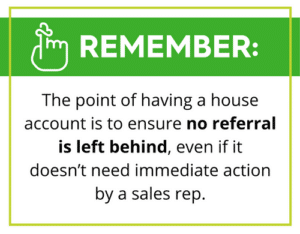In the intricate world of post-acute sales, success is not just about making connections but mastering the art of managing relationships and opportunities.
At the heart of this mastery lies a crucial concept of the “book of business” – more than just a list of names and numbers, it’s an essential element in successful sales management in the post-acute care industry.
In this blog, we’ll focus on PAC sales manager best practices, shining a light on the following:
- What a book of business is and its importance
- The vital aspect of assigning and ranking accounts
- How a CRM can be a game-changer in enhancing your book of business
If you’re ready to strengthen your sales game and understand how to elevate your book of business, let’s dive in.
What is a book of business in post-acute sales, and why is it important?
According to Indeed.com, “A book of business represents a list of clients or accounts you manage as part of a business. This database can help you organize and keep track of your current and previous clients.”
Now that we know what a book of business is let’s dive into why it’s important.
In post-acute sales, a book of business is a vital asset, serving as a centralized database for managing top referral sources. It’s like your trusty sidekick, keeping all your client info and deals super organized.
This “sidekick” helps you shine when connecting with referrals by helping you remember preferences, track progress, and spot new opportunities effortlessly.
Understanding accounts/referrals in your sales team’s book of business
Now that we’ve identified the essence of a book of business let’s explore the anatomy of your sales team’s accounts.
But before we do, we need to cover what a “house account” is, as we will be discussing it throughout this article and want to make it clear for everyone.
What are house accounts?
 Simply put, a house account is technically a “user” in your Customer Relationship Management (CRM) platform that manages or assigns referrals and accounts.
Simply put, a house account is technically a “user” in your Customer Relationship Management (CRM) platform that manages or assigns referrals and accounts.
In addition, this account is assigned to the entire sales hierarchy, as they will be assigned referrals from different territories.
There is one house account for every branch in the organization, and they assign referrals that don’t require any action by a sales rep or referrals sales reps won’t get credit for.
As a sales manager, by utilizing your house account, you can enhance your reporting capabilities inside your CRM by ensuring you and your team aren’t missing unassigned referrals.
For example, if a referral comes in through Google and hasn’t had any touchpoints with a sales rep, it would be assigned to the house account.
Note: A house account does not have a login available and does not require a user license, but it does show up in the reports as any other sales rep on your team.
Remember: The point of having a house account is to ensure no referral is left behind, even if it doesn’t need immediate action by a sales rep.
Who owns which referral in their book of business
Sales Reps
A sales rep’s job is to support the conversion of a referral source to an admission (if needed) and ultimately get credit for the referral and admission.
House Account
House accounts can be a little confusing (see the section above for a detailed explanation), but no action is required when a referral is assigned to a house account. However, as a sales manager, you may assign the referral to a sales rep.
Unassigned Referrals and Contacts
When a referral source or contact comes in unassigned, you must determine whether that contact – or referral – should be assigned to a sales rep or a house account.
Importance of Ranking Accounts in a Book of Business
You should have a defined account rating system for your referral sources as an organization.
You may be asking, “but why? Can’t I have my sales reps go after the accounts I get the most referrals from?”
Yes, but the point of having a rating system is to measure the true value of the partnership with the referral, manage accounts efficiently and effectively, and align sales reps’ focus with your organization’s goal.
In addition, this system will help you:
- Identify the best accounts
- Adjust visit frequency
- Tailor services based on facility expectations
Let’s go over a quick example of a rating system:
In this system, you rank your accounts from A to D, with A being the accounts that send you the most referrals and D being accounts that send you barely any. (see photo)

So, now you may be asking, “But I don’t have any accounts that give me 37+ referrals a month.”
If you don’t have an A account, then look at your B and C accounts to see which ones have the potential to convert to an A account.
Tip: Understandably, referral counts may fluctuate between branches, but your rating system should be the same across your organization. For example, your Wichita, Kansas, branch should have the same rating system as your Los Angeles, California branch.
Note: The example above is a Trella Health best practice. It’s not universal across the board, but you should have a ranking system in place to help you be strategic and determine where your sales reps should spend their time.
Utilizing a CRM when managing your sales reps’ book of business
You’ve covered what a book of business is, who should own which referral account, and the importance of having an account rating system.
As a manager, you must analyze all that information to determine the performance of your sales reps and where they should focus.
Having a Customer Relationship Management (CRM) platform to help you create and pull reports and keep track of Key Performance Indicators (KPIs) is essential.
Let’s look at what KPIs and reports you, as a sales manager, should be looking at daily, weekly, and monthly.
Sales Management Rhythms
Daily
You should monitor new referrals daily, ensure they are being attended to, and help resolve any challenges your team may face throughout the day.
Key Performance Indicators
- Referral Assignment – Appropriate Referral Owner
- Identify New Referral Sources
- Event Activity
- Referral Response Time
Examples of Key Reports to look at in your CRM
- Daily Visit Report (yesterday)
- Advanced Account Executive Event Summary Report
- Referral Views
Weekly
During the week, you should review progress on set goals, identify important accounts to visit, provide updates for your team, and determine where support is needed.
Key Performance Indicators
- Event Frequency at Key Accounts
- Total Event Activity
- Percent To Goal for Admissions
Examples of Key Reports to look at in your CRM
- Daily Visit Report (last week)
- Advanced Account Executive Event Summary Report
- Detailed Account Executive Summary Report (Referrals)
Monthly
Close to the month’s end, you should analyze your sales rep and referral source performance and identify new target accounts.
Key Performance Indicators
- Book of Business Analysis
- Size, rating, frequency
- Close Rate
- Conversion Ratio
- Payer Mix
Note: Close Rate refers to event completion rate, while Conversion Ratio means referrals converting to admissions.
Examples of Key Reports to look at in your CRM
- Detailed Account Executive Activity Report
- Detailed Account Executive Productivity Report
- Admits MTD
- Non-Admits MTD
- Conversion Ratio by Time Period
Note: The examples of key reports in your CRM reflect those available in Trella Health’s Marketscape CRM.
Cultivating Success: Navigating Sales with Your Book of Business
Your book of business isn’t just a list; it’s the compass guiding you toward success in the intricate world of post-acute sales.
From skillfully managing top referral sources to understanding ownership of each referral and implementing a savvy account rating system – your book of business is the key to unlocking efficiency and maximizing opportunities.
As a sales manager, it’s crucial to harness the power of your book of business wisely by utilizing tools like a CRM to analyze and fine-tune your sales team’s efforts and performance, ensuring a strategic and effective approach.
With a well-organized book of business and a thoughtful strategy, you and your team will not only meet but exceed your sales goals.
Interested in learning more about leveraging an industry-specific CRM with your book of business?
Click here to request a free personalized demo today and elevate your sales game.
















